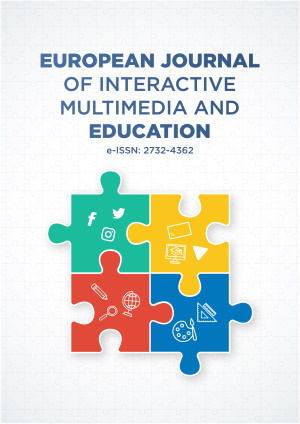Research Article
E-Learning Platform: A Sustainable Approach for Students’ Learning during and after Coronavirus Pandemic in Oyo State Secondary Schools, Oyo State, Nigeria
More Detail
1 Obafemi Awolowo University, Ile-Ife, NIGERIA* Corresponding Author
European Journal of Interactive Multimedia and Education, 2(1), January 2021, e02103, https://doi.org/10.30935/ejimed/9361
Submitted: 10 August 2020, Published: 03 January 2021
OPEN ACCESS 2369 Views 1341 Downloads
ABSTRACT
E-learning approach cannot be underrated in sustaining teaching-learning activities in the schools. This paper reports a survey done that assessed the E-learning approach organized by organized by Oyo State government for Oyo State secondary school students. The study adopted quantitative approach of descriptive survey. The target populations of the study comprised only Senior Secondary School students in class three (SSS 3) within Oyo State Secondary Schools. The sample of 200 students was selected using simple random, purposive and convenience sampling techniques respectively. An instrument was used for the study. The data were analysed using frequencies, percentage scores, pie charts, mean and standard deviation (SD). The findings showed students were highly aware e-learning programmes (60%) and highly participated during the programmes (62.5%). The study equally indicated that e-learning programmes on radio and television organized by Oyo State government was very highly efficient (57%). The study further indicated that inadequate power supply (x=3.45) and high cost of subscriptions to the satellite television stations (x=3.45) were factors hindering the students’ participation during the E-learning programmes on radio and television. The study recommended that Government should continue the e-learning programmes during and after CONVID-19 might have fully eradicated and they should equally incorporate other electronic devise for teaching-learning activities such as Zoom, Google Classroom and social media.
CITATION (APA)
Olowo, B. F. (2021). E-Learning Platform: A Sustainable Approach for Students’ Learning during and after Coronavirus Pandemic in Oyo State Secondary Schools, Oyo State, Nigeria. European Journal of Interactive Multimedia and Education, 2(1), e02103. https://doi.org/10.30935/ejimed/9361
REFERENCES
- Akhter, N. (2011). Evaluation of educational television programmes for distance learning. The Turkish Online Journal of Educational Technology, 10(4), 188-194.
- Demuyakor, J. (2020). Coronavirus (COVID-19) and online learning in higher institutions of education: A survey of the perceptions of Ghanaian international students in China. Online Journal of Communication and Media Technologies, 10(3), e202018. https://doi.org/10.29333/ojcmt/8286
- Dominic, S., Ibrahim, A. M., Kareem, M. A., & Chukwuemeka, E. J. (2020). Impact of Covid-19 pandemic on people with disabilities and its implications on special education practice in Nigeria. International Journal of Innovative Science and Research Technology (IJISRT), 5(6), 803-808.
- Familusi, E. B., & Owoeye, P. O. (2014). An assessment of the use of radio and other means of information dissemination by the residents of Ado- Ekiti, Ekiti-State, Nigeria. Library Philosophy and Practice (e-journal), 1-29. Retrieved July 14, 2020, from http://digitalcommons.unl.edu/libphilprac/1088
- Federal Ministry of Education (FME, 2020). Compilation by FME NEMIS on the status of state government and FCT interventions on the implementation of digital learning during lockdown. E-learning Resources: Abuja.
- Fredericksen, E., Pickett, A., Pelz, W., Swan, K., & Shea, P. (2007). Student satisfaction and perceived learning with online courses-principles and examples from the SUNY Learning Network. (cited 2007 Jun 25). Retrieved from http://www.sloan.org/conference/proceedings/1999summer/papers/99summer_fredericksen2.pdf
- Hasanzadeh, M. (2002). Electronic learning. Tehran: Tadbir Publication (Persian).
- Koohang, A., & Harman, K. (2005). Open source: A metaphor for e-learning. Informing Science. The International Journal of an Emerging Transdiscipline, 8, 75-86. https://doi.org/10.28945/488
- Mayer, E. R., & Ruth, C. C. (2011). E-Learning and the Science of Instruction: Proven Guidelines for Consumers. USA: Pfeiffer Publishers, San Francisco.
- News Agency of Nigeria (2020). Students in graduating classes resume in Oyo. Pulse Nigeria.
- Ogbole, J. (2019). Uses and gratifications of radio educational programmes by senior secondary school students in Northeast geo-political region, Nigeria (Unpublished Ph. D Thesis), Benue State University, Makurdi
- Olumorin, C. O., Aderoju, M. A., & Onojah, A. O. (2018). Students’ awareness and utilization of educational broadcasts to learn in Ogbomoso, Oyo State Nigeria. Turkish Online Journal of Distance Education (TOJDE), 19(3), 182-192. https://doi.org/10.17718/tojde.445122
- Omiko, A. (2016). Using computer instruction (Unpublished Lecture Note). Department of Science Education, Ebonyi State University, Abakaliki.
- Omiko, A. (2018). A Effect of Children’s Radio/Television Programmes on Basic Science and Technology Education. International Journal of Science Research and Education, 5(3), 6254-626.
- Thiele J. E. (2003). Learning patterns of online students. Journal of Nursing Education, 42(8), 364-366. https://doi.org/10.3928/0148-4834-20030801-08
- UNESCO (2020). COVID-19 Educational Disruption and Response. Retrieved from https://en.unesco.org/covid19/educationresponse
- UNESCO (4 March, 2020). 290 million students out of school due to COVID-19: UNESCO releases first global numbers and mobilizes response. Retrieved on 6 July 2020 from https://en.unesco.org/news
- World Health Organization, (2020). Q & A on Coronaviruses, (COVID-19). Retrieved from https://www.who.int/news-room/q-a-detail/q-a-coronaviruses

 The articles published in this journal are licensed under the CC-BY Creative Commons Attribution International License.
The articles published in this journal are licensed under the CC-BY Creative Commons Attribution International License.